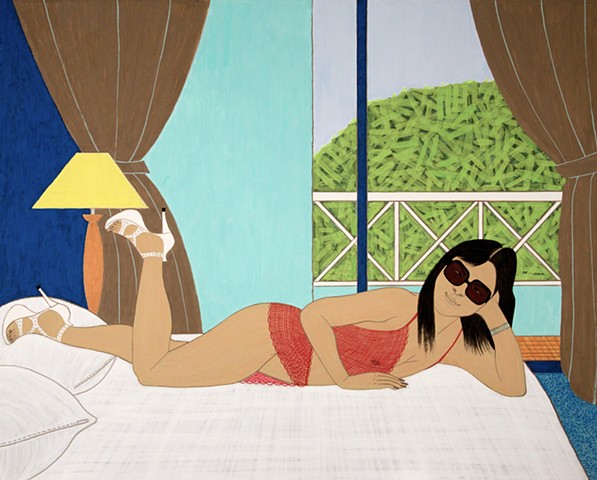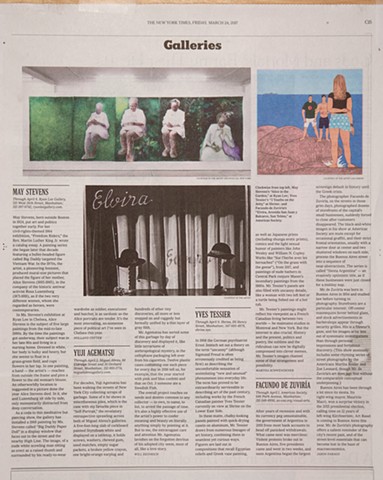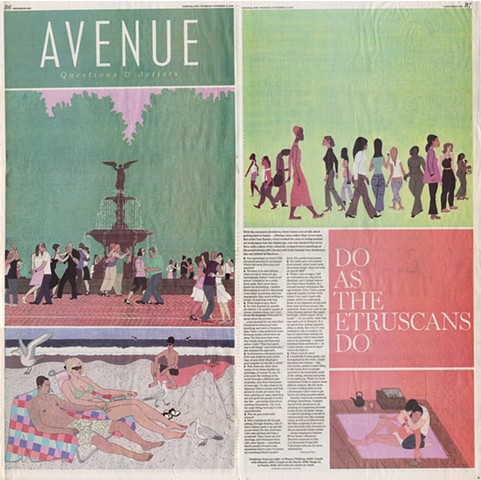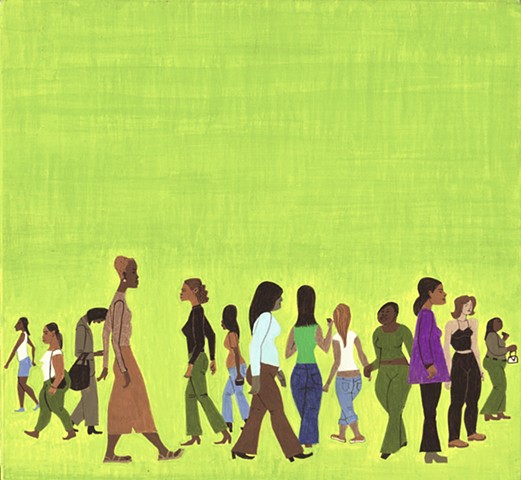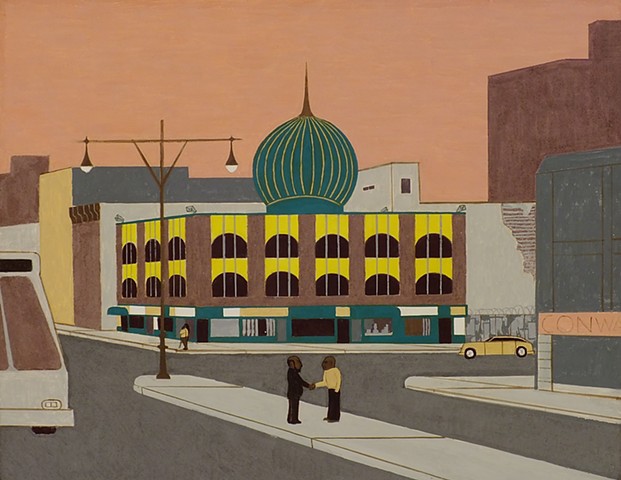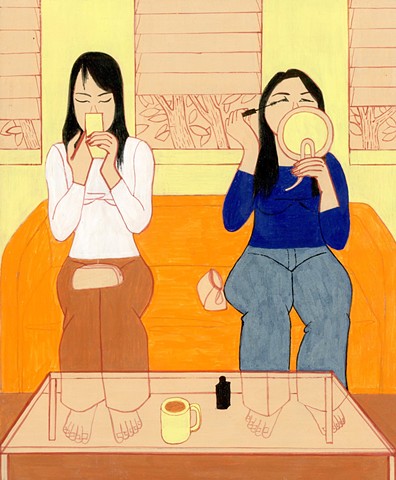ART IN AMERICA - review - June/July 2017
Yves Tessier: Woman in Shades Reclining on Bed, 2017, casein on aluminum, 42 by 52 inches; at Shrine.
Art In America Reviews Jun. 01, 2017
Yves Tessier
New York,
at Shrine
by Eric SutphinYves Tessier’s paintings, ten of which were on view in this exhibition, feature stylized figures that have been reduced to essential elements yet retain a vitality and distinct presence. His favored medium is casein on aluminum. Casein is a rapidly drying milk-based paint that was developed in ancient Egypt and was used in commercial illustration into the 1960s. Tessier nods to the medium’s long history in his works, which formally allude to Egyptian friezes, illuminated manuscripts, and comic book illustrations.
Tessier, who was born in 1955 in Montreal, maintains studios in both Montreal and Harlem. New York’s Central Park was the backdrop for a number of the works on view, including Ghost Bathers 2 (2017), which depicts six women in and around a teal-colored body of water—some of them standing on rocks, others wading in the water, and another, located in the background, approaching a black bird perched on a branch. While the figures look sedate and withdrawn, their black fingernails give them a witchy appearance, as if they are a coven preparing for a ritual. Ambiguity is a central theme in Tessier’s work, which puts forth a world that seems at once archaic and contemporary.
Explicitly referencing Japanese shunga (erotic) woodblock prints, Le Mask (2016) shows two women engaged in a pre-coital moment with BDSM undertones. One of the women lies on her back, while the other, wearing a black sleeping mask, climbs on top of her. The supine figure appears distorted: her head and hair are flattened and seem to melt into a cerulean teardrop-shaped pillow. Apart from a few faint surface irregularities, the wall behind the women is a solid field of high-key crimson.
Tessier’s scenes are generally still and quiet. His figures often feel separated from or indifferent to one another. When they do communicate, it is usually through subtle body language. In 3 Youths on a Jetty (2015), for instance, two men standing in the middle ground and a woman facing them in the foreground seem to “speak” to each other through a series of coded hand gestures. One of the men gathers the fabric of his shorts in one hand, the other man makes a gesture recalling the letter “e” in American Sign Language, and the woman crosses one arm at a right angle behind her back. The title figure in Woman in Shades Reclining on Bed (2017) faces us while lounging on her side in a red mesh negligee, white studded heels, and large thick-rimmed sunglasses. In the grand tradition of the odalisque, she commands our attention with her casual confidence.
Tessier’s figures, despite their simplified nature, feel grounded in reality: small details like the crease in the back of a knee, a knowing expression, or a pair of high heels give them specificity and rescue them from feeling like hollow signifiers. As revealed in his preparatory drawings, which were not on view, Tessier carefully plots out each element in his paintings. The reductive scenes he crafts recall the cells of comic books, as if each one were a single moment plucked from a continuously unfolding drama.New York Times, March 24, 2017
THE NEW YORK TIMES, MARCH 24, 2017What to See in New York Galleries This Week
YVES TESSIER
Yves Tessier’s “3 Youths on the Jetty,” at Shrine. Credit Courtesy of the artist and Shrine.Through April 9. Shrine, 191 Henry Street, Manhattan; 347-693-4979, shrine.nyc.
In 1906 the German psychiatrist Ernst Jentsch set out a theory on the term “uncanny” (although Sigmund Freud is often erroneously credited as being first) as describing the uncomfortable sensation of assimilating “new and unusual” phenomenon into everyday life. The term has proved to be extraordinarily serviceable in describing art of the past century, including works by the French Canadian painter Yves Tessier currently on view at Shrine on the Lower East Side.In these matte, chalky-looking panels painted with quick-drying casein on aluminum, Mr. Tessier draws from numerous lineages of art history, combining them in seamless yet curious ways. Figures are laid out in compositions that recall Egyptian reliefs and Greek vase painting, as well as Japanese prints (including shunga erotic prints), comics and the light sexual humor of painters like John Wesley and William N. Copley. Works like “Sur l’herbe avec les bernaches” (“On the grass with the geese”), from 2017, and paintings of nude bathers in Central Park conjure Manet’s incendiary paintings from the 1860s. Mr. Tessier’s panels are also filled with uncanny details, like a woman with two left feet or a turtle being fished out of a hot tub.
Mr. Tessier’s paintings might reflect his viewpoint as a French Canadian living between two worlds — he maintains studios in Montreal and New York. But the internet is also crucial. History and the present, politics and poetry, the sublime and the ridiculous can now be digitally compressed into clever memes. Mr. Tessier’s images channel some of that strangeness and possibility.
MARTHA SCHWENDENER
National Post
Interview Yves Tessier, National Post, Leah Sandals
DO AS ETRUSCANS DO
Leah Sandals, National Post, Published: Thursday, November 12, 2009With the economic slowdown, there's been a lot of talk about getting back to basics -- offering value rather than va-va-voom. But artist Yves Tessier, who's worked for years to bring ancient art techniques into the digital age, was way ahead of the curve. Now, with a show of his colourful, stripped-down paintings at Montreal's Projex-Mtl, Tessier tells Leah Sandals how fundamentals can indeed be fabulous.
Q Your paintings are kind of like storybook pictures for grownups. What's the story from your perspective?
A The story is in each picture; what you see is what you get. Interestingly, before I went to art school I wanted to be a comic-book artist. But I never had a knack for storytelling. I studied filmmaking as well but discovered I was better at painting and cinematography than novel-writing or scripts. So painting took over.
Q What inspires you, then?
A I'm very inspired by ancient art history. I do modern people of course, modern times, but I sort of use the language of the past to speak about the present.
A key moment for me was when I finished art school and went travelling, and went to Tarquinia, Italy. There, I descended into some Etruscan tombs, which blew me away. The frescos in there were very simply done, just lines and colour. I said, "This was a good way to do things." And eventually, I also adopted this approach.
Q So if someone a thousand years from now looked at your paintings, do you think they'd get a good snapshot of city life in 2009?
A Well, there are other documents of our times besides my paintings, of course! To me, it's a bit more like looking at the world through a different pair of glasses, ones from thousands of years ago. I'm also inspired by Japanese Ukiyo-e prints and that period in Greek art where they were painting on vases, depicting not just gods but people in everyday life -- grooming themselves, washing themselves. I try to do the same thing, but keep it a bit unpredictable.
Q How do you create each picture?
A Well, I transform life through editing, through drawing. Like if I have a dinner party, I can get into a zone where I'm very observant. I also take pictures and keep a scrapbook. Then I trace my own drawings, and recompose them with other figures -- sometimes they're people I've never met, sometimes they're ones I've invented, sometimes they're people I know. It's a pretty long process.
Q You make your own paints from scratch, which must make the process longer. How and why do you do this?
A When I was younger, I did art restoration as a day job in Montreal, and I helped restore the Notre-Dame Basilica. So I learned ancient techniques like egg tempera. Now, I have a great pigment supplier in New York, where I live, and I work with casein, which is a milk paint. Some of my pigments are ground from semi-precious stones, like malachite. Some were used in the Greco-Roman period, like caput mortuum, which means "dead heads" -- it's an earthy violet that was used a lot in Pompeii. So I do spend time mixing pigment, often in shells. But even if I was working in oils or acrylics, I'd have to spend time mixing colours anyway. I don't have shadows in my paintings -- another tendency from ancient art -- so I need certain colours to show where the light is.
Q What's next for you?
A I would like to keep going, and be surprised by the work. I might introduce new themes -- like, who knows, cement trucks! Often, it still comes down to people involved in the three basic needs of life: eating, sleeping and going to the bathroom. When I'm more established I'd like to explore more difficult subjects, like the erotic. I've been holding back on that a bit because I don't want to get known for being sensationalistic.
Overall, I want to do a multitude of things. Sometimes, I imagine that all of the situations in my paintings are happening simultaneously all over the globe. Always, I create the paintings to be able to read at a small size, like a postage stamp, as well as at billboard size, like from a highway. In the end, I want the whole body of work to be like an Alexander Calder mobile--always hanging in a balance.
- Yves Tessier: ‘Situations Récentes’ continues to Dec. 5 at Montreal's Projex-Mtl. Visit projex-mtl.com for more information.Canadian Art
Yves Tessier, 13 Women Walking, 2009, casein on wood panel.
Must-Sees
Yves Tessier: Jewels of the Present
November 12, 2009 BY Canadian ArtYves Tessier’s vibrant, small-scale paintings—rarely bigger than 11 x 17 and sometimes as small as a postage stamp—depict the complexities of contemporary urban life in well-edited, measured doses. Originally from Quebec and now based in New York, Tessier gained note last year in the Montreal press for an exhibition at the artist-run centre Optica, “Situations Récentes,” that hung 80 of his little paintings in what was suggested to be a kind of simultaneous narrative. This season, dealer Projex-Mtl is offering “Situations Récentes II,” a smaller show of new works by the artist. Many aspects of Tessier’s continuing practice could be considered archaic: working with the rare medium of casein paint; being inspired by the strong- line, posture-oriented graphic traditions of ancient art, in particular Etruscan frescoes; and focusing on the classical subject matter of eating, grooming and street life. Still, despite the artist’s more dusty reference points, a Tessier show still holds the promise of freshness—revamping traditions of the past to provide a jewel-like facet of the present. (372 Ste-Catherine O, Montreal QC)
Le DEVOIR
Yves Tessier, 2001 - 2007, Mosk, casein on gesso on wood.
THE WORLD IN 80 PANELS
by Jerome DelgadoLe DEVOIR, Saturday 26 - Sunday 27, January 2008, p.E6.
(translated from the French)Recent Situations
Yves Tessier
Optica, 372, rue Sainte-Catherine Ouest, suite 508
until February 23rdThe scenes follow one another but aren't necessary alike. And there are more than 80 of them! A pack of bikers here, a bedroom scene there, an urban landscape following upon a sea of stromatolites (limestone fossils): more than 80 panels, mini-panels for the most part (some less than three inches wide), make up the rather unusual and peculiarly refreshing art of Yves Tessier, which opens the winter program at Optica.
Unusual, because this expatriate Montreal painter in New York manufactures his own colours based on raw pigments and casein-substance normally used in the process of making cheese. And refreshing, because this falsely naive universe seems to harbour no intention of teaching anyone a lesson. "Recent Situations," as the series is titled, exudes a pure pleasure in painting.
For Yves Tessier, "Recent Situations" also represents a come back. Yves who, you ask? A decorative painter in another life, I'm told at Optica, Tessier's artistic career goes back more than 30 years. At least, he was part of "FORUM 76," curated by Leo Rosshandler at the Montreal Museum of Fine Arts. Of course, that was 1976.
He has participated in other group shows, curated by reputable painters: "PEINTURE," directed by David Blatherwick at Galerie Clack in 1991; and "LUSH," at the Centre Articule, in 1995, of which one curator was Michael Merrill. His last solo, of watercolours also goes back too 1995. Might as well say that, with "Recent Situations," many are discovering, or will be discovering Yves Tessier.
ONE AND THE SAME MOMENT
Discontinuous in appearance, these paintings on wood, realized between 2001 and 2007, from a highly coherent whole nonetheless. A whole that could go on for ever without tiring us, so much are they a portrait of the world. These situations are not just recent: they are, in there frieze-like installation, the representation of a single moment.
The world is vast, and here are 80 slices of everyday life to inhabit it; some scenes are oriental in inspiration, others Western, some are in between--like the mosque in New York. Tessier's cultural references are obvious. Far from innocent, he takes a wicked pleasure in depicting his maja desnuda, that reclining female nude inaugurated by Goya, and there's the Gilles Villeneuve Racetrack and the Parc Lafontaine, which exist only in his imagination but effectively translate their origin.
Humour and dexterity, unique colours and simple forms compose each panel. The titles descriptive, are often charged with irony, like the Seven Women Walking with Pizza Guy, or Group Activity, the nature of whose activity we are left to divine for ourselves. The characters, heavily outlined, nearly fall into caricature, though they never become grotesque. The scenes are often cocky, like the tiny "pizza guy," or that jogger who, for want of missing perspective, deals an involuntary blow to a passerby.
It is in fact the modesty of his compositions that fascinates us. A simple contrast between two tones, or between a treatment in outline and another in solid colour, can, for instance, allow a figure to stand out. There are exquisite colours luminous and shimmering (with yellow here, green there), but others, too, like the seductive browns, and those glimmering greys, concocted of iron ore pigment.
Alternating horizontal and vertical orientations, small and very small scale (the latter no less detailed), "Recent Situations" hardly lacks rhythm. It also has the particularity of not offering itself in a single narrative flow: as many tales can be derived from it as there are visitors to the exhibitions.
Collaborator to Le DEVOIR
.....................................................................................................................
Yves Tessier, 2001-2007, Mosquée, caséine sur gesso sur bois.LE MONDE EN 80 TABLEAUX
Humour et couleurs uniques foisonnent dans le retour d'un peintre faussement naïLe DEVOIR, 26 janvier 2008 | Jérôme Delgado | Arts visuels
Situations récentes
Yves Tessier
Centre Optica, 372, rue Sainte-Catherine Ouest, suite 508
Jusqu'au 23 févrierLes scènes se suivent mais ne se ressemblent pas nécessairement. Et dire qu'il y en a plus de 80. Un peloton de cyclistes ici, une scène de lit là, un paysage urbain suivant une mer de stromatolites — des fossiles calcaires. En plus de 80 tableaux, tableautins pour la plupart (certains ne font pas trois pouces), voici l'art bien particulier et plutôt rafraîchissant d'Yves Tessier, en ouverture de la programmation hivernale du centre Optica.
Particulier parce que ce peintre montréalais exilé à New York fabrique ses propres couleurs à base de pigments naturels et de caséine — substance habituellement utilisée dans la confection de fromages. Rafraîchissant parce que cet univers naïf, faussement naïf, ne semble pas être porté par la prétention de faire la leçon à quiconque. Situations récentes, le titre de l'ensemble, respire le simple plaisir de peindre.
Situations récentes signifie aussi, pour Yves Tessier, un retour. Yves qui? demandez-vous. Peintre décorateur dans une autre vie, nous dit-on du côté d'Optica, Tessier mène une carrière artistique depuis plus de trente ans. Du moins était-il de l'expo Forum 76, montée par Leo Rosshandler au Musée des beaux-arts de Montréal. En 1976, évidemment.
Il a, à l'occasion, participé à d'autres manifestations de groupe, montées par des peintres réputés: une Peinture dirigée par David Blatherwick à la galerie Clark en 1991, Lush au centre Articule, en 1995, dont un des commissaires était Michael Merril. Son dernier solo, d'aquarelles, remonte d'ailleurs à cette même année 1995. Aussi bien dire qu'avec Situations récentes beaucoup découvrent, découvriront, Yves Tessier.
UN SEUL ET MÊME INSTANT
Suite sans queue ni tête, en apparence, ces peintures sur bois, réalisées entre 2001 et 2007, forment cependant un tout fort cohérent. Un tout qui pourrait se poursuivre sans doute à l'infini, sans nous lasser, tant ça se veut comme un portrait du monde. Ces situations ne sont pas seulement récentes, elles sont, dans leur exhibition en frise, la représentation d'un seul et même instant.
Le monde est vaste, et voici 80 différents quotidiens qui l'habitent, certains d'inspiration orientale, d'autre occidentale, certains entre les deux — une mosquée de New York. Les références culturelles de Tessier sont évidentes. Rien d'innocent chez lui, qui prend un malin plaisir à reproduire ses majas desnudas, cette figure de la femme couchée, nue, lancée par Goya. Et il y a ce Circuit Gilles Villeneuve et ce Parc Lafontaine qui n'existent que dans son imaginaire mais qui traduisent bien ses origines.
Humour et doigté, couleurs uniques et formes simples composent chacun des tableaux. Les titres, descriptifs, volent parfois haut en ironie, tel ce Seven Women Walking with Pizza Guy ou ce Group Activity, dont on vous laisse le soin d'imaginer de quelle activité il s'agit. Les personnages, aux contours bien définis, frôlent la caricature, sans jamais tomber dans le grotesque. Les scènes sont souvent cocasses, à l'instar de ce minuscule livreur de pizza, ou même du joggeur qui assène un coup de poing involontaire, absence de perspective aidant, à une passante.
C'est d'ailleurs la modestie des compositions qui fascine chez Yves Tessier. Une simple opposition entre deux tons, entre un traitement dessiné et un autre plus en aplat, qui permet, par exemple, à la figure de se détacher. Et il y a ces couleurs rares, lumineuses et chatoyantes (un jaune ici, un vert là), mais pas seulement. Les bruns séduisent aussi, puis il y a ces gris qui scintillent, résultat du pigment métallique utilisé.
Alternant formats horizontaux et verticaux, petits et très petits formats — ceux-ci n'en sont pas moins détaillés —, l'exposition Situations récentes ne manque certainement pas de rythme. Elle a aussi la particularité de ne pas s'offrir en une seule suite narrative. Les récits que l'on peut en tirer n'ont d'égal, en quantité, que le nombre de visiteurs.
Collaborateur du DEVOIR
AKIMBO
Yves Tessier, 'Make Up', 2001-07, casein on gesso on wood
Isa Tousignant for AKIMBO, February 14th, 2008
In Optica's main room rests a real treat in the form of 80-odd paintings ranging from miniature to petite in scale by Yves Tessier. All lined up on the horizontal to create an effect of simultaneous narrative - as if all are happening at the same time, but in different parts of the world - there are scenes of ordinary life, like girls lounging in the nude (a recurring image, because, you know, all us girls would do that all day if we could), couples preparing for bed, women putting on makeup and crowds ambulating this way and that. Tessier paints the works with homemade paints, created with casein and gesso on wood, which gives the works a jewel-like vibrancy. His style of bold, simple line contours filled with colour and devoid of shadows resulted from his realization that, at various times in history, it is an aesthetic that has existed in Etruscan, Minoan, Egyptian, Assyrian, Chinese and Aztec art. Thus Tessier aligns his work with this age-old tradition.MIRROR
Mirror Jan 24 - Jan 30 2007 - Vol. 23 No. 31
GOOD THINGS, SMALL PACKAGES
Eighty-five little paintings by New York-based artist Yves Tessier are now hanging on the walls at Optica (372 Ste-Catherine W., # 508). The bottom edge of each work is placed at the same height around the room, apparently to imitate how he is used to looking at them lined up on his studio table in Harlem.
These paintings are executed in the quick-drying, rarely used medium of casein paint on panel. Tessier uses no shading; instead, his work is flat and linear. He claims his approach is “suggestive of Etruscan, Egyptian or Assyrian painting,” but it made me think more of a contemporary comic book.
The exhibition, titled Recent Situations, features quirky and appealing narratives that are easy to appreciate. The people Tessier depicts are often women, and what is refreshing (but unfortunately far too uncommon) is their ethnic diversity. Throughout the show, a parade of individuals of Asian, African and European decent are involved in various ordinary activities guaranteed to bring a smile to your lips. Until Feb. 23, info: (514) 874-16 66 or www.optica.ca.
by CHRISTINE REDFERN
